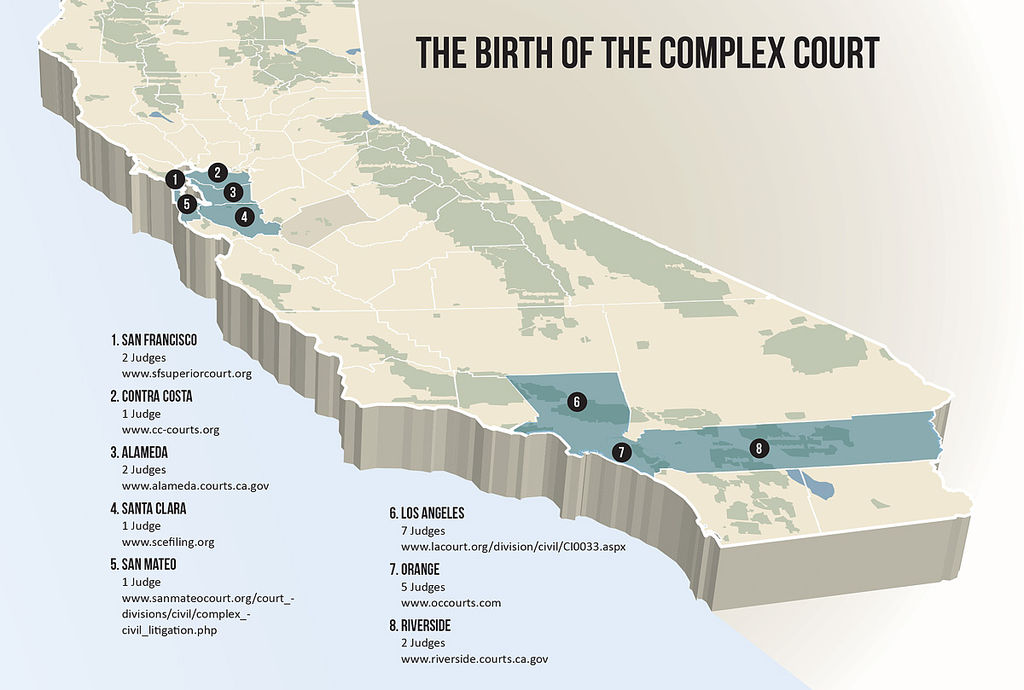California's Complex Court Program
Publication | 01.19.16
Taking on the Tough Cases: California's complex court program aims to streamline costly, time-consuming litigation.
For decades, complex lawsuits have been a challenge for state courts and litigants across the nation, often unnecessarily consuming time and money for all involved. These cases can clog court dockets and may create uncertainty for the parties when, for example, different judges handle discovery, motion practice, and ultimately trial. Such cases have been especially common in California—so much so that the state has created courts that focus specifically on handling complex litigation in an efficient and timely manner. This approach has met with success and has provided a model for similar courts in other regions.
California's complex courts are specialized departments within the civil divisions of several of the state's superior courts. The complex court program was established after a state task force was set up in the mid-1990s to consider the creation of separate courts that would focus on business-related issues. "The task force determined that creating those special business courts would not be the best approach," says Nathanial Wood, Commercial Litigation counsel in Crowell & Moring's Los Angeles office. "But its work led it to suggest that the state instead create a broader type of court that could address all types of complex civil litigation." This recommendation led to the launch of a pilot program in 2000 to test the complex court concept.
In 2015, the complex courts received permanent funding, and there are now eight of them in operation (see map below).

[Click to access a high resolution version of the
California Complex Court Map]
The California Rules of Court define the complex case fairly broadly, calling it "an action that requires exceptional judicial management to avoid placing unnecessary burdens on the court or the litigants and to expedite the case, keep costs reasonable, and promote effective decision making by the court, the parties, and counsel." This breadth sets California apart, as other states generally use these courts primarily to handle commercial disputes. As the rules reflect, multi-party litigation such as class actions or antitrust, securities, construction defect, and mass environmental or toxic tort cases will often qualify as complex. But parties often overlook the fact that the courts have discretion to designate a matter as complex, so even two-party disputes can get assigned to the complex division when counsel can explain to the court at the outset why both the parties and the court would benefit from the enhanced case management found in the complex courts.
California's approach is designed to give each court the time and resources needed to focus on complex cases while attempting to resolve these cases as efficiently as possible. Judges in the complex courts typically have reduced caseloads compared to judges in non-complex courts. They are often more experienced and are expected to look for ways to handle cases with greater efficiency. A key element of the program is its use of an individual calendar system, as opposed to the master calendar system used in many other state courts. This means that the complex courts typically have a single judge assigned to a case from beginning to end, from deciding motions to overseeing discovery and ultimately deciding the case.
WHICH COURT IS RIGHT FOR WHOM?
With the complex courts in place, venue decisions become more complicated than the typical state court/federal court distinction when parties are litigating complex matters. Plaintiffs must determine not only whether to file in state or federal court (if there is federal jurisdiction), but also to consider which county to file in—a county with a complex division, with the possibility of being assigned to complex, or a county without a complex division—to avoid it. Defendants, too, have more choices—rather than removing to federal court, which is often the standard play when even shaky grounds for removal are present, defendants must now consider whether the benefits of the complex division outweigh the costs of a potentially protracted and expensive remand battle in federal court. In making such decisions, litigants need to examine some fundamental qualities of the three types of courts. These include:
Active and unified case management. An average of 3,700 case filings per judicial position in California state courts (in 2013-14) makes it virtually impossible for judges in non-complex courts to provide substantial amounts of oversight. And many non-complex courts are"master calendar," meaning that different judges handle different parts of the case. In contrast, the complex courts provide for a single judge with resources to supervise the case from start to finish. The parties can expect early, and frequent, in-depth discussions with the court regarding how every aspect of the case will proceed. Federal courts in California fall somewhere between these two extremes and are dependent on the particular judge.
The likelihood of success on a dispositive motion. In California state courts, the rules make it more difficult for defendants to be granted summary judgment. But while the rules are the same for a complex and non-complex state case, with the individual calendar system and emphasis on expedited proceedings and closer judicial oversight, complex court judges will often spend the time to consider early briefing of key legal issues that can streamline the case. "So plaintiffs may face more risk of having their case dismissed through a motion in federal court or one of the complex courts," says Gregory Call, chair of Crowell & Moring's Commercial Litigation Group, head of the firm's San Francisco office, and a 2015 National Law Journal Litigation Trailblazer. "On the other hand, if you're a plaintiff that thinks that you can adjudicate a significant point by motion, the federal or complex court might be the right choice."
How easily the parties will be able to get documents and information. Compared to complex and federal courts, non-complex California state courts generally are less active in supervising discovery. "This can make it easier for parties to get information," says Van Nguyen, a Commercial Litigation partner in Crowell & Moring's Orange County office. The complex court, with a single assigned judge and a mandate to streamline the process, is more likely to rein in discovery. And federal courts are now working under new rules that direct judges to consider whether discovery puts an undue burden on the parties. "That's going to really separate the federal and regular state courts because the concept of proportionality is now baked into the federal discovery rules, and that does not exist in the state courts," she says.
The standards governing the admission of expert evidence. California's rules covering limitations to expert testimony and the qualification of experts are not nearly as evolved as federal rules. "So, if you have a damages theory that is not rock solid and requires more causal jumps from an expert, you are more likely to succeed in state court," says Call. In addition, under a state court master calendar system, issues such as the admissibility of experts are not decided until the eve of trial, as opposed to the complex court system where the parties can raise issues regarding admissibility of certain expert testimony earlier, potentially saving time and money.
Time to trial. For plaintiffs hoping to leverage the threat of a trial, having a court set a near-term trial date is key. "That might be the single most important factor for deciding what court you want to be in," says Call. This issue is highly court-dependent. In some California federal courts, a party can be looking at more than two years before trial. In state court, the goal is a 100 percent clearance rate for all civil matters within two years—though the statistics reflect that this goal is not met, and the percentage of matters getting resolved in that two-year window is decreasing. Generally speaking, the complex courts tend to be at the longer end of the spectrum. There, Call says, "the judge is more likely to want to focus efforts not on working toward a trial date, but in attempting to focus and narrow the case through the early adjudication of legal issues or undisputed factual issues."
Understanding these fundamental differences can help litigants determine which type of court is most appropriate for them. However, they also need to pay attention to the basics. Even with these differently structured courts, says Call, "you still need to do your homework. You need to understand the specifics of the courts—the individual judge's approach and the local rules of the court—as you compare the options you have across the different kinds of courts."
[PDF Download: 2016
|
|
[Web Index: 2016 Litigation
|
Contacts
Insights
Publication | May 25-27, 2008
“ISI mitigation using bit-edge equalization in high-speed backplane data transmission,” in IEEE International Conference on Communications, Circuits and Systems (ICCCAS 2008), pp. 589 - 593.
Publication | 04.16.24
Rochester, NY, Diocese's Creditors To Mull Rival Ch. 11 Plans
Publication | 04.15.24




